Sanja Fidler
NVIDIA, University of Toronto, Vector Institute
DMM-Net: Differentiable Mask-Matching Network for Video Object Segmentation
Sep 27, 2019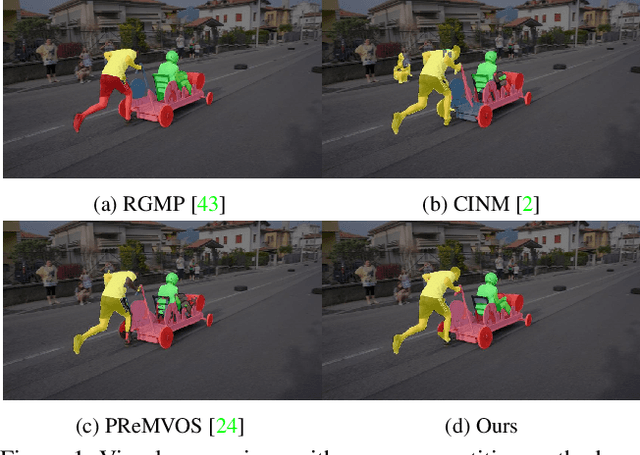
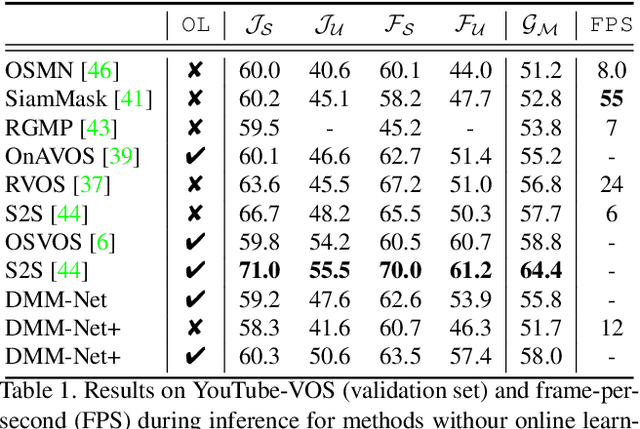
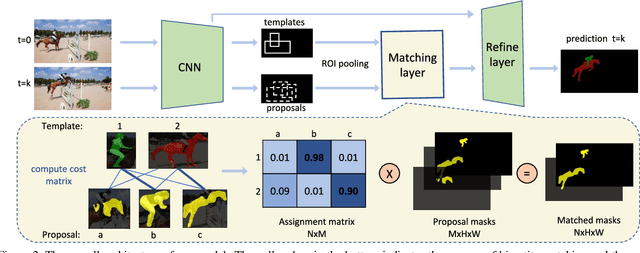
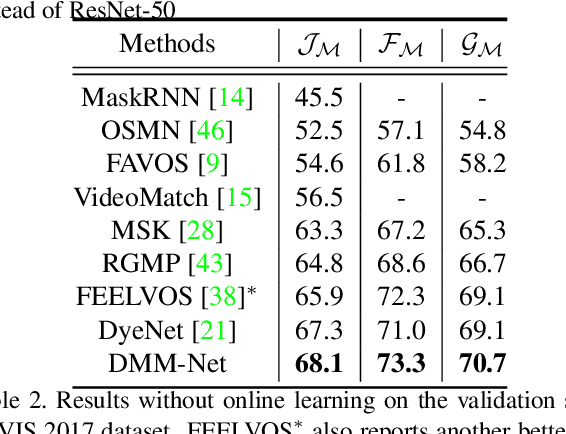
Abstract:In this paper, we propose the differentiable mask-matching network (DMM-Net) for solving the video object segmentation problem where the initial object masks are provided. Relying on the Mask R-CNN backbone, we extract mask proposals per frame and formulate the matching between object templates and proposals at one time step as a linear assignment problem where the cost matrix is predicted by a CNN. We propose a differentiable matching layer by unrolling a projected gradient descent algorithm in which the projection exploits the Dykstra's algorithm. We prove that under mild conditions, the matching is guaranteed to converge to the optimum. In practice, it performs similarly to the Hungarian algorithm during inference. Meanwhile, we can back-propagate through it to learn the cost matrix. After matching, a refinement head is leveraged to improve the quality of the matched mask. Our DMM-Net achieves competitive results on the largest video object segmentation dataset YouTube-VOS. On DAVIS 2017, DMM-Net achieves the best performance without online learning on the first frames. Without any fine-tuning, DMM-Net performs comparably to state-of-the-art methods on SegTrack v2 dataset. At last, our matching layer is very simple to implement; we attach the PyTorch code ($<50$ lines) in the supplementary material. Our code is released at https://github.com/ZENGXH/DMM_Net.
A Theoretical Analysis of the Number of Shots in Few-Shot Learning
Sep 25, 2019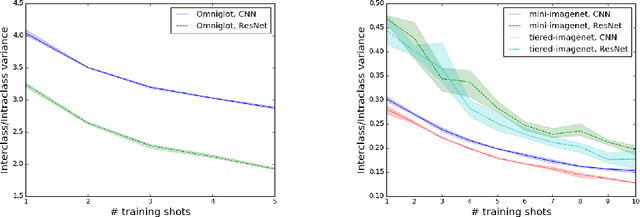
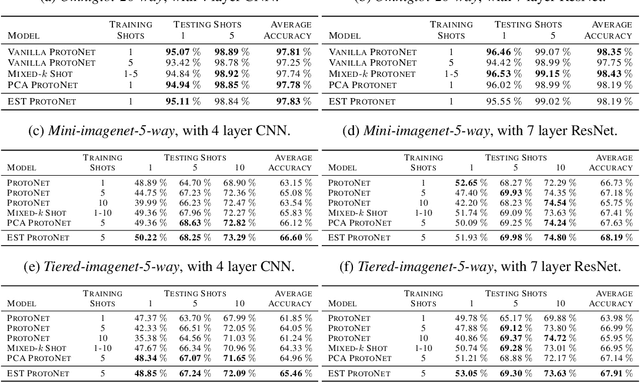
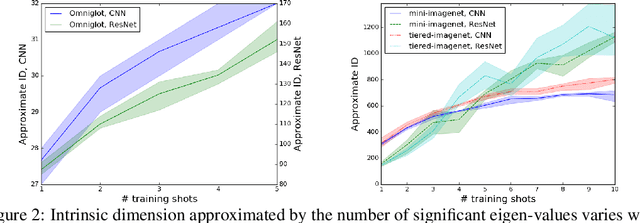

Abstract:Few-shot classification is the task of predicting the category of an example from a set of few labeled examples. The number of labeled examples per category is called the number of shots (or shot number). Recent works tackle this task through meta-learning, where a meta-learner extracts information from observed tasks during meta-training to quickly adapt to new tasks during meta-testing. In this formulation, the number of shots exploited during meta-training has an impact on the recognition performance at meta-test time. Generally, the shot number used in meta-training should match the one used in meta-testing to obtain the best performance. We introduce a theoretical analysis of the impact of the shot number on Prototypical Networks, a state-of-the-art few-shot classification method. From our analysis, we propose a simple method that is robust to the choice of shot number used during meta-training, which is a crucial hyperparameter. The performance of our model trained for an arbitrary meta-training shot number shows great performance for different values of meta-testing shot numbers. We experimentally demonstrate our approach on different few-shot classification benchmarks.
Video Face Clustering with Unknown Number of Clusters
Aug 20, 2019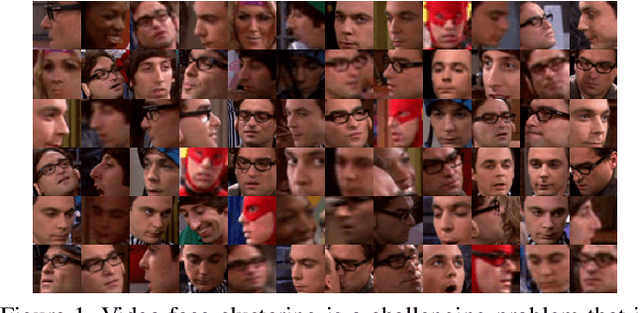
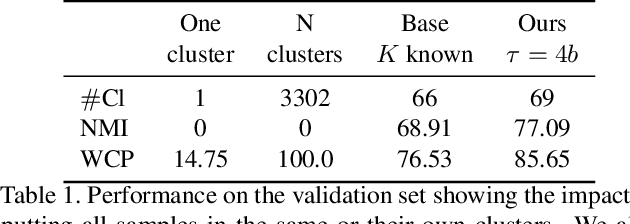
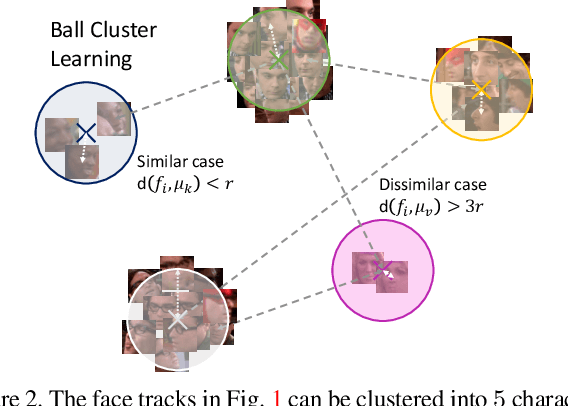

Abstract:Understanding videos such as TV series and movies requires analyzing who the characters are and what they are doing. We address the challenging problem of clustering face tracks based on their identity. Different from previous work in this area, we choose to operate in a realistic and difficult setting where: (i) the number of characters is not known a priori; and (ii) face tracks belonging to minor or background characters are not discarded. To this end, we propose Ball Cluster Learning (BCL), a supervised approach to carve the embedding space into balls of equal size, one for each cluster. The learned ball radius is easily translated to a stopping criterion for iterative merging algorithms. This gives BCL the ability to estimate the number of clusters as well as their assignment, achieving promising results on commonly used datasets. We also present a thorough discussion of how existing metric learning literature can be adapted for this task.
Learning to Predict 3D Objects with an Interpolation-based Differentiable Renderer
Aug 03, 2019
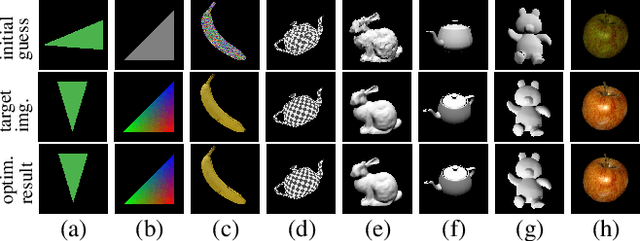

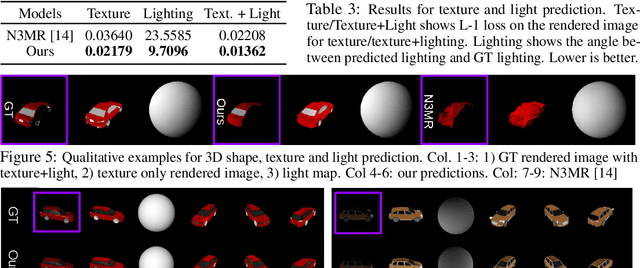
Abstract:Many machine learning models operate on images, but ignore the fact that images are 2D projections formed by 3D geometry interacting with light, in a process called rendering. Enabling ML models to understand image formation might be key for generalization. However, due to an essential rasterization step involving discrete assignment operations, rendering pipelines are non-differentiable and thus largely inaccessible to gradient-based ML techniques. In this paper, we present DIB-R, a differentiable rendering framework which allows gradients to be analytically computed for all pixels in an image. Key to our approach is to view foreground rasterization as a weighted interpolation of local properties and background rasterization as an distance-based aggregation of global geometry. Our approach allows for accurate optimization over vertex positions, colors, normals, light directions and texture coordinates through a variety of lighting models. We showcase our approach in two ML applications: single-image 3D object prediction, and 3D textured object generation, both trained using exclusively using 2D supervision. Our project website is: https://nv-tlabs.github.io/DIB-R/
Gated-SCNN: Gated Shape CNNs for Semantic Segmentation
Jul 12, 2019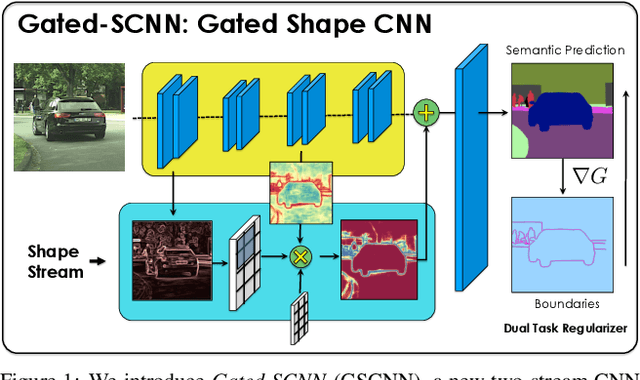
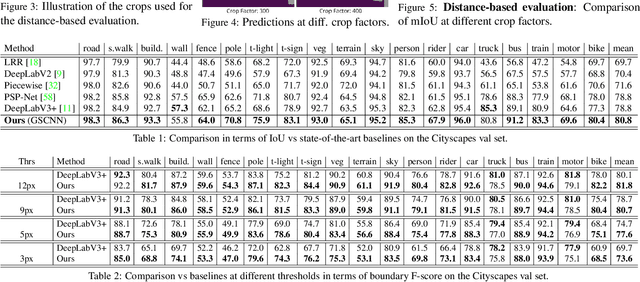


Abstract:Current state-of-the-art methods for image segmentation form a dense image representation where the color, shape and texture information are all processed together inside a deep CNN. This however may not be ideal as they contain very different type of information relevant for recognition. Here, we propose a new two-stream CNN architecture for semantic segmentation that explicitly wires shape information as a separate processing branch, i.e. shape stream, that processes information in parallel to the classical stream. Key to this architecture is a new type of gates that connect the intermediate layers of the two streams. Specifically, we use the higher-level activations in the classical stream to gate the lower-level activations in the shape stream, effectively removing noise and helping the shape stream to only focus on processing the relevant boundary-related information. This enables us to use a very shallow architecture for the shape stream that operates on the image-level resolution. Our experiments show that this leads to a highly effective architecture that produces sharper predictions around object boundaries and significantly boosts performance on thinner and smaller objects. Our method achieves state-of-the-art performance on the Cityscapes benchmark, in terms of both mask (mIoU) and boundary (F-score) quality, improving by 2% and 4% over strong baselines.
Neural Graph Evolution: Towards Efficient Automatic Robot Design
Jun 12, 2019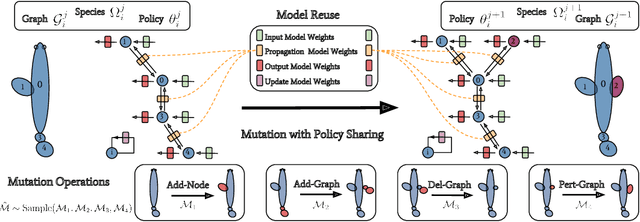


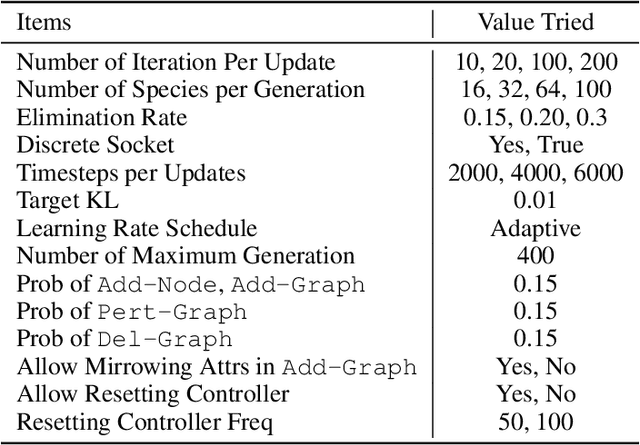
Abstract:Despite the recent successes in robotic locomotion control, the design of robot relies heavily on human engineering. Automatic robot design has been a long studied subject, but the recent progress has been slowed due to the large combinatorial search space and the difficulty in evaluating the found candidates. To address the two challenges, we formulate automatic robot design as a graph search problem and perform evolution search in graph space. We propose Neural Graph Evolution (NGE), which performs selection on current candidates and evolves new ones iteratively. Different from previous approaches, NGE uses graph neural networks to parameterize the control policies, which reduces evaluation cost on new candidates with the help of skill transfer from previously evaluated designs. In addition, NGE applies Graph Mutation with Uncertainty (GM-UC) by incorporating model uncertainty, which reduces the search space by balancing exploration and exploitation. We show that NGE significantly outperforms previous methods by an order of magnitude. As shown in experiments, NGE is the first algorithm that can automatically discover kinematically preferred robotic graph structures, such as a fish with two symmetrical flat side-fins and a tail, or a cheetah with athletic front and back legs. Instead of using thousands of cores for weeks, NGE efficiently solves searching problem within a day on a single 64 CPU-core Amazon EC2 machine.
EigenDamage: Structured Pruning in the Kronecker-Factored Eigenbasis
May 15, 2019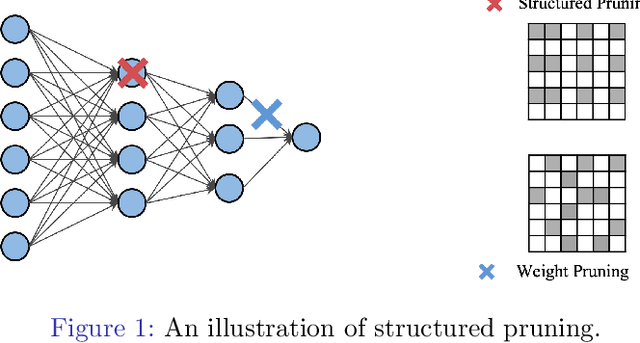
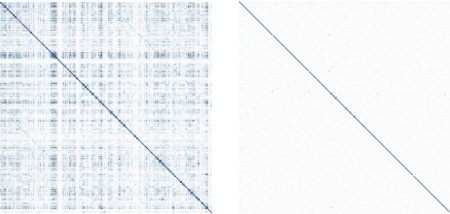
Abstract:Reducing the test time resource requirements of a neural network while preserving test accuracy is crucial for running inference on resource-constrained devices. To achieve this goal, we introduce a novel network reparameterization based on the Kronecker-factored eigenbasis (KFE), and then apply Hessian-based structured pruning methods in this basis. As opposed to existing Hessian-based pruning algorithms which do pruning in parameter coordinates, our method works in the KFE where different weights are approximately independent, enabling accurate pruning and fast computation. We demonstrate empirically the effectiveness of the proposed method through extensive experiments. In particular, we highlight that the improvements are especially significant for more challenging datasets and networks. With negligible loss of accuracy, an iterative-pruning version gives a 10$\times$ reduction in model size and a 8$\times$ reduction in FLOPs on wide ResNet32.
DARNet: Deep Active Ray Network for Building Segmentation
May 15, 2019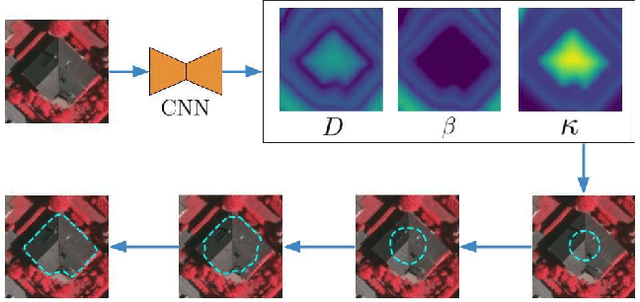

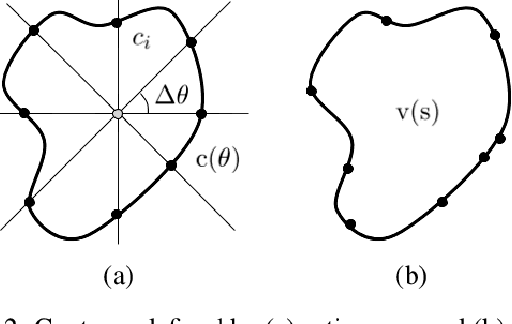
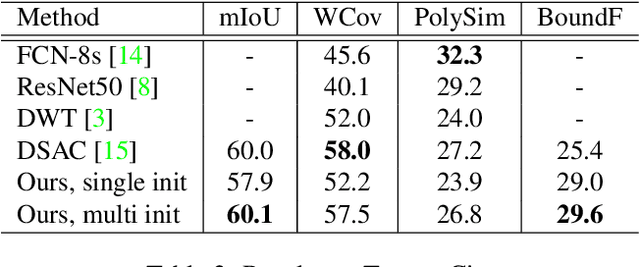
Abstract:In this paper, we propose a Deep Active Ray Network (DARNet) for automatic building segmentation. Taking an image as input, it first exploits a deep convolutional neural network (CNN) as the backbone to predict energy maps, which are further utilized to construct an energy function. A polygon-based contour is then evolved via minimizing the energy function, of which the minimum defines the final segmentation. Instead of parameterizing the contour using Euclidean coordinates, we adopt polar coordinates, i.e., rays, which not only prevents self-intersection but also simplifies the design of the energy function. Moreover, we propose a loss function that directly encourages the contours to match building boundaries. Our DARNet is trained end-to-end by back-propagating through the energy minimization and the backbone CNN, which makes the CNN adapt to the dynamics of the contour evolution. Experiments on three building instance segmentation datasets demonstrate our DARNet achieves either state-of-the-art or comparable performances to other competitors.
Meta-Sim: Learning to Generate Synthetic Datasets
Apr 25, 2019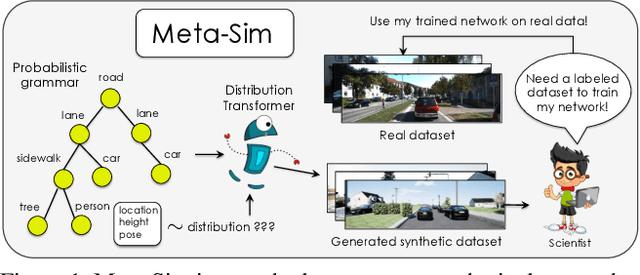
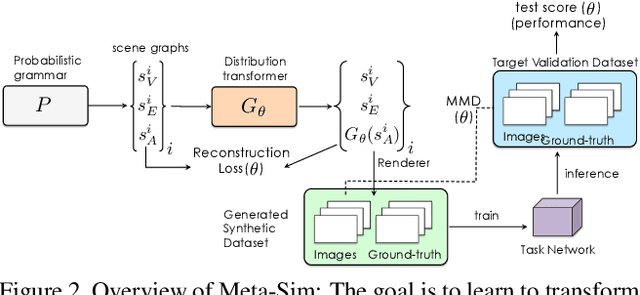
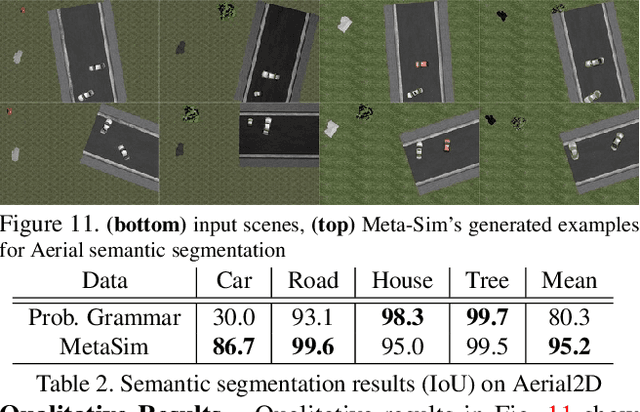

Abstract:Training models to high-end performance requires availability of large labeled datasets, which are expensive to get. The goal of our work is to automatically synthesize labeled datasets that are relevant for a downstream task. We propose Meta-Sim, which learns a generative model of synthetic scenes, and obtain images as well as its corresponding ground-truth via a graphics engine. We parametrize our dataset generator with a neural network, which learns to modify attributes of scene graphs obtained from probabilistic scene grammars, so as to minimize the distribution gap between its rendered outputs and target data. If the real dataset comes with a small labeled validation set, we additionally aim to optimize a meta-objective, i.e. downstream task performance. Experiments show that the proposed method can greatly improve content generation quality over a human-engineered probabilistic scene grammar, both qualitatively and quantitatively as measured by performance on a downstream task.
Devil is in the Edges: Learning Semantic Boundaries from Noisy Annotations
Apr 16, 2019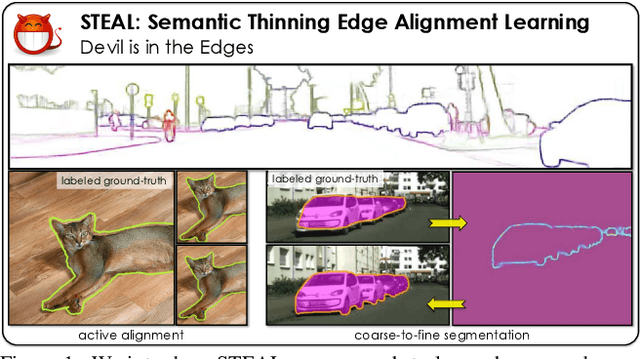
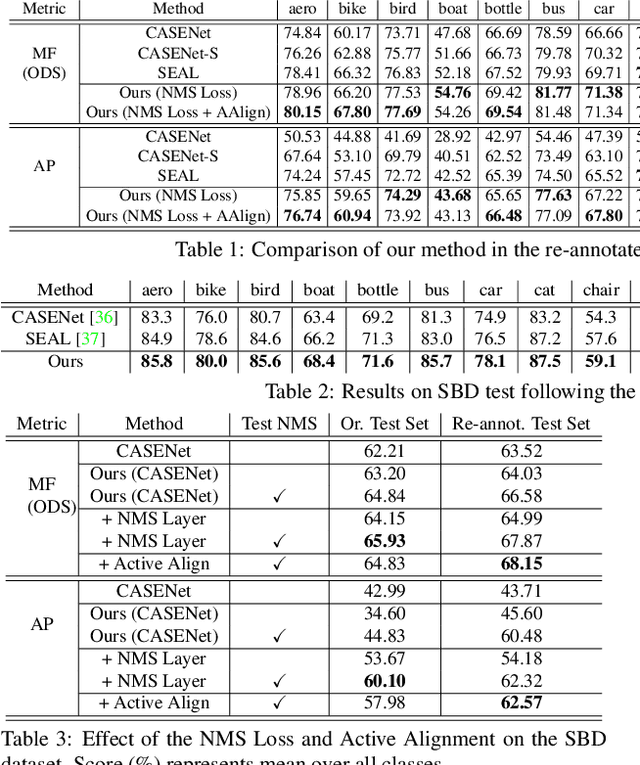

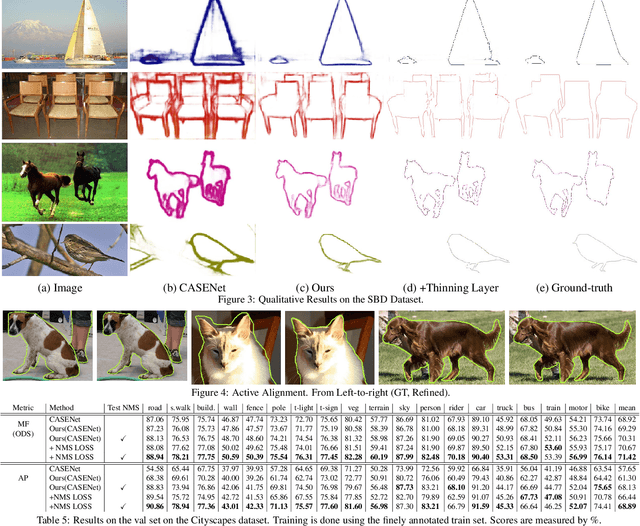
Abstract:We tackle the problem of semantic boundary prediction, which aims to identify pixels that belong to object(class) boundaries. We notice that relevant datasets consist of a significant level of label noise, reflecting the fact that precise annotations are laborious to get and thus annotators trade-off quality with efficiency. We aim to learn sharp and precise semantic boundaries by explicitly reasoning about annotation noise during training. We propose a simple new layer and loss that can be used with existing learning-based boundary detectors. Our layer/loss enforces the detector to predict a maximum response along the normal direction at an edge, while also regularizing its direction. We further reason about true object boundaries during training using a level set formulation, which allows the network to learn from misaligned labels in an end-to-end fashion. Experiments show that we improve over the CASENet backbone network by more than 4% in terms of MF(ODS) and 18.61% in terms of AP, outperforming all current state-of-the-art methods including those that deal with alignment. Furthermore, we show that our learned network can be used to significantly improve coarse segmentation labels, lending itself as an efficient way to label new data.
* Accepted as a CVPR 2019 oral paper (Project Page: https://nv-tlabs.github.io/STEAL/)
 Add to Chrome
Add to Chrome Add to Firefox
Add to Firefox Add to Edge
Add to Edge